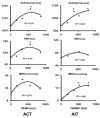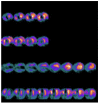Complementary Role of Combined Indirect and Direct Cardiac Sympathetic (Hyper)Activity Assessment in Patients with Heart Failure by Spectral Analysis of Heart Rate Variability and Nuclear Imaging: Possible Application in the Evaluation of Exercise Training Effects
- PMID: 35735810
- PMCID: PMC9225187
- DOI: 10.3390/jcdd9060181
Complementary Role of Combined Indirect and Direct Cardiac Sympathetic (Hyper)Activity Assessment in Patients with Heart Failure by Spectral Analysis of Heart Rate Variability and Nuclear Imaging: Possible Application in the Evaluation of Exercise Training Effects
Abstract
In chronic heart failure (CHF), abnormalities in cardiac autonomic control, characterized by sympathetic overactivity, contribute to the progression of the disease and are associated with an unfavorable prognosis. Assessing cardiac autonomic status is clinically important in the management of patients with CHF. To this aim, heart rate variability (HRV) analysis has been extensively used as a non-invasive tool for assessing cardiac autonomic regulation, and has been shown to predict the clinical outcome in patients with CHF. Adrenergic nerve activity has also been estimated using iodine-123 (I-123) metaiodobenzylguanidine (MIBG), a noradrenaline analogue. MIBG is an analogue of norepinephrine sharing the same cellular mechanism of uptake, storage, and release in presynaptic sympathetic neurons. As an innervation tracer, 123I-MIBG allows for the evaluation of cardiac sympathetic neuronal function. Cardiac MIBG imaging has also been reported to predict a poor clinical outcome in CHF. MIBG provides direct information on the function of the presynaptic sympathetic nerve endings, whereas HRV, which depends on postsynaptic signal transduction, reflects the end-organ response of the sinus node. The aim of this brief review is to provide the reader with some basic concepts regarding the spectral analysis of HRV and MIBG, highlighting what is known about their respective roles in detecting cardiac sympathetic hyperactivity in CHF and, in perspective, their possible combined use in assessing non-pharmacological treatments in patients with CHF and reduced ejection fraction, with a particular focus on the effects of exercise training.
Keywords: MIBG; cardiac autonomic regulation; exercise training; heart failure; heart rate variability.
Conflict of interest statement
The authors declare no conflict of interest.
Figures



Similar articles
-
Cardiac sympathetic activity as measured by myocardial 123-I-metaiodobenzylguanidine uptake and heart rate variability in idiopathic dilated cardiomyopathy.Am J Cardiol. 1999 Jun 1;83(11):1548-51. doi: 10.1016/s0002-9149(99)00145-9. Am J Cardiol. 1999. PMID: 10363869
-
Interictal cardiac autonomic dysfunction in temporal lobe epilepsy demonstrated by [(123)I]metaiodobenzylguanidine-SPECT.Brain. 2001 Dec;124(Pt 12):2372-82. doi: 10.1093/brain/124.12.2372. Brain. 2001. PMID: 11701592 Clinical Trial.
-
ACE inhibition reduces cardiac iodine-123-MIBG release in heart failure.J Nucl Med. 1997 Jul;38(7):1085-9. J Nucl Med. 1997. PMID: 9225795
-
Iodine-123-metaiodobenzylguanidine scintigraphy in risk stratification of sudden death in heart failure.Rev Port Cardiol. 2013 Jun;32(6):509-16. doi: 10.1016/j.repc.2012.11.003. Epub 2013 Jun 2. Rev Port Cardiol. 2013. PMID: 23731734 Review. English, Portuguese.
-
The role of nuclear medicine technique in evaluating electrophysiology in diabetic hearts especially with 123I-MIBG cardiac SPECT imaging.Minerva Endocrinol. 2009 Sep;34(3):263-71. Minerva Endocrinol. 2009. PMID: 19859048 Review.
Cited by
-
The Heart's Function as a Pump Assessed via Impedance Cardiography and the Autonomic System Balance in Patients with Early-Stage Acromegaly.J Clin Med. 2024 Jan 11;13(2):395. doi: 10.3390/jcm13020395. J Clin Med. 2024. PMID: 38256528 Free PMC article.
-
Effects of Concurrent, Within-Session, Aerobic and Resistance Exercise Training on Functional Capacity and Muscle Performance in Elderly Male Patients with Chronic Heart Failure.J Clin Med. 2023 Jan 17;12(3):750. doi: 10.3390/jcm12030750. J Clin Med. 2023. PMID: 36769399 Free PMC article.
-
Differences in Long-Term Heart Rate Variability between Subjects with and without Metabolic Syndrome: A Systematic Review and Meta-Analysis.J Cardiovasc Dev Dis. 2023 May 9;10(5):203. doi: 10.3390/jcdd10050203. J Cardiovasc Dev Dis. 2023. PMID: 37233170 Free PMC article. Review.
-
Towards a More Individually Tailored Exercise Prescription for Promoting Cardiovascular Health.J Cardiovasc Dev Dis. 2022 Nov 18;9(11):401. doi: 10.3390/jcdd9110401. J Cardiovasc Dev Dis. 2022. PMID: 36421936 Free PMC article.
-
Effects of levothyroxine in subclinical hypothyroidism and heart failure with reduced ejection fraction: An open-label randomized trial.Cell Rep Med. 2024 Apr 16;5(4):101473. doi: 10.1016/j.xcrm.2024.101473. Epub 2024 Mar 26. Cell Rep Med. 2024. PMID: 38537636 Free PMC article. Clinical Trial.
References
-
- Brouwer J., Van Veldhuisen D.J., In’T Veld A.J.M., Haaksma J., Dijk W.A., Visser K.R., Boomsma F., Dunselman P.H.J.M., Lie K.I. Prognostic value of heart rate variability during long-term follow-up in patients with mild to moderate heart failure. J. Am. Coll. Cardiol. 1996;28:1183–1189. doi: 10.1016/S0735-1097(96)00279-3. - DOI - PubMed
Publication types
LinkOut - more resources
Full Text Sources
Research Materials

